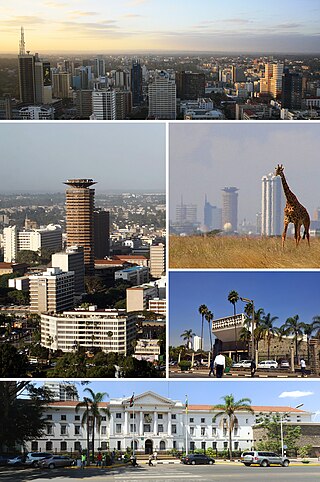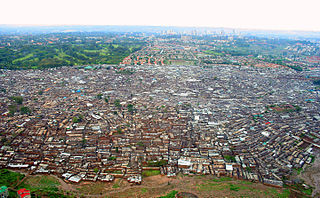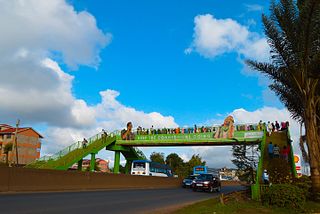Related Research Articles

Nairobi is the capital and largest city of Kenya. The name is derived from the Maasai phrase Enkare Nairobi, which translates to 'place of cool waters', a reference to the Nairobi River which flows through the city. The city proper had a population of 4,397,073 in the 2019 census. The city is commonly referred to as The Green City in the Sun.

Kibera is a division of Nairobi Area, Kenya, and neighbourhood of the city of Nairobi, 6.6 kilometres (4.1 mi) from the city centre. Kibera is the largest slum in Nairobi, and the largest urban slum in Africa. The 2009 Kenya Population and Housing Census reports Kibera's population as 170,070, contrary to previous estimates of one or two million people. Other sources suggest the total Kibera population may be 500,000 to well over 1,000,000 depending on which slums are included in defining Kibera.
Raila is a part of Kibera slum in Nairobi. Other parts of Kibera include Laini Saba, Lindi, Makina, Kianda, Gatwekera, Soweto East, Kichinjio, Kisumu Ndogo, Makongeni and Mashimoni.
Laini Saba is a slum of Nairobi, the capital of Kenya. It belongs to the major slum of Kibera. As for Lindi, another village within Kibera, its population is estimated at 100,000. Soweto East is another village belonging to Kibera. The price of water there clearly is above Nairobi average. A Laini Saba Primary School exists.
Lindi is a suburb of Nairobi, the capital of Kenya. It belongs to the major slum of Kibera. As for Laini Saba, another village within Kibera, its population is estimated at 100,000. Soweto East is another village belonging to Kibera. The price of water there clearly is above Nairobi average. A Lindi Friends Primary School exists.
Soweto East is a part of Kibera slum in Nairobi. Its population has been estimated at 70,000 persons. Slum residents have to pay more than others for water. Other parts of Kibera include Laini Saba, Lindi, Makina, Kianda, Mashimoni, Gatuikira, Kisumu Ndogo and Siranga.
Soweto East is a part of major Kibera slum in Nairobi. A school KidStar Academy is in Soweto West. Other parts of Kibera include Soweto East, Laini Saba Lindi, Makina, Kianda, Mashimoni, Gatuikira, Kisumu Ndogo and Siranga.

Uthiru is a settlement transversing in both Nairobi County and Kiambu County on the northwest side of the city centre of Nairobi. It is located between Kikuyu and Kangemi. The number of residents likely exceeds 100,000. It hosts a number of public institutions including University of Nairobi, Upper Kabete Campus, Kabete national polytechnic, and AHITI Kabete. ILRI has its headquarters in Uthiru.
Gatwekera (Gatuikira) is a part of Kibera slum in Nairobi. Its population likely exceeds 70,000. Water & Sanitation for the Urban Poor is active there. Many of its residents are Luo. Médecins Sans Frontières used to run a health center there. Other parts of Kibera include Laini Saba, Lindi, Makina, Kianda, Mashimoni, Soweto East, Kisumu Ndogo and Siranga.
Kisumu Ndogo is a name given to "villages" that are part of two informal settlements in Nairobi, Kenya, Kibera and Korogocho. Kisumu Ndogo means little Kisumu. Most dwellers of these villages are believed to be of low income. Nowadays, there are many villages across the country called Kisumu Ndogo. for example, there are in fact two Kisumu Ndogo villages in Kilifi county alone, one in Malindi sub county and one in Kilifi North sub county. There is also one in Mombasa and Nakuru Counties.
Mashimoni is a part of Kibera slum in Nairobi. Mashimoni Primary School, Facing the Future School, Mashimoni Good Samaritan School for the Orphans (MAGOSO) and Mashimoni Squatters Schools exist. Many of its residents are Luhyas and Kambas. It is part of Langata Constituency. Other parts of Kibera include Laini Saba, Lindi, Makina, Kianda, Gatwekera, Soweto East, Kisumu Ndogo and Siranga.
Mugumoini is a part of Kibera slum in Nairobi. A Mugumoini Primary School exists. It is part of Langata Constituency. Many residents are Luhyas. Mugumoini has a PCEA church. Other parts of Kibera include Laini Saba, Lindi, Makina, Kianda, Gatwekera, Soweto East, Kisumu Ndogo, Makongeni, Kichinjio and Mashimoni.
Kichinjio is a part of Kibera slum in Nairobi. Kichinjio has a New Adventure Secondary School and a Kicoshep Primary School. Furthermore, Kichinjio has a mosque. Other parts of Kibera include Laini Saba, Lindi, Makina, Kianda, Gatwekera, Soweto East, Kisumu Ndogo, Makongeni and Mashimoni.
Kambi Muru is a part of Kibera slum in Nairobi. It borders to Mashimoni, Lindi, Kisumu Ndogo and Makina. Kambi Muru is the site of Kibera Academy. It is also a part of the area of Christ the King Catholic Church. Other parts of Kibera include Laini Saba, Lindi, Makina, Kianda, Gatwekera, Soweto East, Kichinjio, Kisumu Ndogo, Makongeni and Mashimoni.
Sarang'ombe is a part of Kibera in Nairobi.Some parts of Sarang'ombe ward include Ayany Estate. It is part of Kibra Constituency. An Ushirika Health Centre is in Sarang'ombe. Other parts of Kibera include Laini Saba, Lindi, Makina, Kianda, Gatwekera, Soweto East, Kichinjio, Kisumu Ndogo, Makongeni and Mashimoni.
Shilanga is a part of Kibera slum in Nairobi. It has at least one church. It has a major Luo population. Other parts of Kibera include Laini Saba, Lindi, Makina, Kianda, Gatwekera, Soweto East, Kichinjio, Kisumu Ndogo, Makongeni and Mashimoni.
The following is a timeline of the history of the city of Nairobi, Kenya.
Editar Adhiambo Ochieng is a Kenyan activist and feminist who advocates for women's rights and supports survivors of sexual violence. In 2020, Ochieng became the first winner of the Wangari Maathai Award in Kenya for her contribution to curb the spread of COVID-19 pandemic in the Kibera slum.
Woodley is a residential neighbourhood in the city of Nairobi. It is approximately 4.4 kilometres (2.7 mi) west of the central business district. It generally a low-density suburb that lies north of Africa's largest slum, Kibera. Woodley Estate was completed in 1950 and named after the then mayor of Nairobi, Sir Richard Woodley.
Nyayo Highrise is a residential neighbourhood in the city of Nairobi. It is approximately 3.5 kilometres (2.2 mi) southwest of the central business district of Nairobi. Initially a slum upgrading project, the estate was built in an effort by the national government to provide its citizens with affordable housing.
References
- ↑ "Archived copy". Archived from the original on 11 August 2011. Retrieved 21 August 2010.
{{cite web}}: CS1 maint: archived copy as title (link) - ↑ "Nairobi Christian Outreach Centre - Kenya". Archived from the original on 22 January 2011. Retrieved 21 August 2010.
- ↑ "Kenya: The unseen majority: Nairobi's two million slum-dwellers" . Retrieved 4 December 2016.
- ↑ Eva Muthoni Kagiri. "USING SUSTAINABLE TECHNOLOGY TO UPGRADE SANITATION. CASE STUDY: SOWETO EAST, KIBERA" (PDF). Jyx.jyu.fi. Retrieved 27 November 2021.
- ↑ "Archived copy" (PDF). Archived from the original (PDF) on 7 December 2010. Retrieved 3 September 2010.
{{cite web}}: CS1 maint: archived copy as title (link)